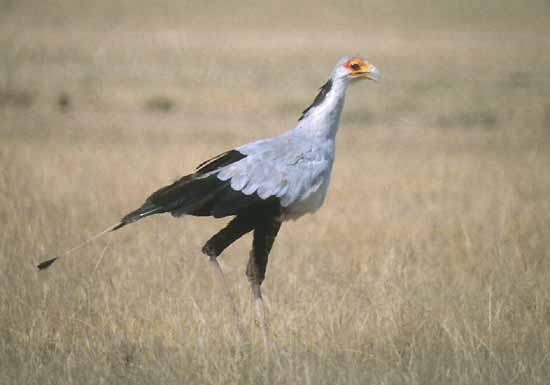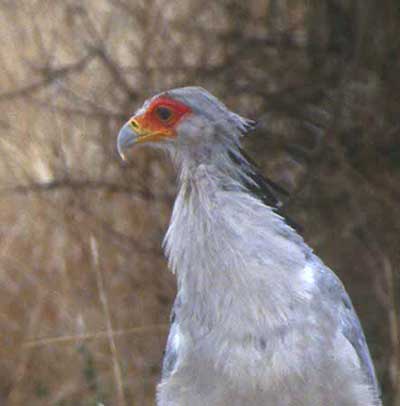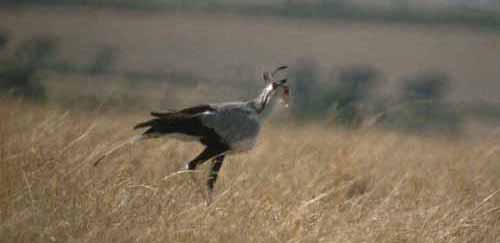SECRETARYBIRD Sagittariidae
-
Species in family 1
-
Species observed [DR] 1 (100%)
-
Species photo'd [DR] 1
 Striding across the plains of east Africa, the Secretarybird is as characteristic
and distinctive a symbol of the African veldt as an ostrich, a cheetah,
or a lion. This fine photo by Dale & Marion Zimmerman of a Secretarybird
(left) shows it in a characteristic stance in its most typical habitat.
It is a large bird, standing nearly 4 feet (1.2 m) tall. The sexes are
alike. The long legs are clothed in black "breeches" and those legs can
produce a powerful kick which can disable most other animals, but the feet
have very little grasping ability (Kemp 1994). The long black crest, flowing
down like a ponytail in this shot, can be elevated when the bird is excited
or alert. The beak is heavy and curved and, with the bare skin around the
face, recalls caracaras of the New World. These head details are nicely
shown in the shot (below) by Ed Harper.
Striding across the plains of east Africa, the Secretarybird is as characteristic
and distinctive a symbol of the African veldt as an ostrich, a cheetah,
or a lion. This fine photo by Dale & Marion Zimmerman of a Secretarybird
(left) shows it in a characteristic stance in its most typical habitat.
It is a large bird, standing nearly 4 feet (1.2 m) tall. The sexes are
alike. The long legs are clothed in black "breeches" and those legs can
produce a powerful kick which can disable most other animals, but the feet
have very little grasping ability (Kemp 1994). The long black crest, flowing
down like a ponytail in this shot, can be elevated when the bird is excited
or alert. The beak is heavy and curved and, with the bare skin around the
face, recalls caracaras of the New World. These head details are nicely
shown in the shot (below) by Ed Harper.
 The
Secretarybird has always been placed in its own monotypic family near the
birds of prey, and molecular analysis confirms a relationship with the
falcons and hawks, on the one hand, and the storks on the other (in flight,
the Secretarybird does recall a stork). While the modern Secretarybird
is confined to Africa, fossil evidence suggests close relatives once existed
in the Middle East and southern Europe (Kemp 1994). As they live in similar
habitat to several species of caracara, and they capture live food like
falcons, it is not surprising that they have evolved to fill a niche in
Africa that is similar to the caracaras of the New World. However, there
is another New World family that is not so closely related that has evolved
a similar size and body shape: the Seriemas
of
southern South America. I was surprised when I first saw a Secretarybird,
and again years later when I first saw a seriema, of the large size and
the graceful strides of both birds. One big difference, though, is that
sereimas are quite vocal -- they live is much denser scrub country
-- while secretarybirds are usually silent (but enraged secretarybirds
can give a geed guttural croak of near roaring intensity; Kemp 1994).
The
Secretarybird has always been placed in its own monotypic family near the
birds of prey, and molecular analysis confirms a relationship with the
falcons and hawks, on the one hand, and the storks on the other (in flight,
the Secretarybird does recall a stork). While the modern Secretarybird
is confined to Africa, fossil evidence suggests close relatives once existed
in the Middle East and southern Europe (Kemp 1994). As they live in similar
habitat to several species of caracara, and they capture live food like
falcons, it is not surprising that they have evolved to fill a niche in
Africa that is similar to the caracaras of the New World. However, there
is another New World family that is not so closely related that has evolved
a similar size and body shape: the Seriemas
of
southern South America. I was surprised when I first saw a Secretarybird,
and again years later when I first saw a seriema, of the large size and
the graceful strides of both birds. One big difference, though, is that
sereimas are quite vocal -- they live is much denser scrub country
-- while secretarybirds are usually silent (but enraged secretarybirds
can give a geed guttural croak of near roaring intensity; Kemp 1994).
Secretarybirds occur in all types of grassland and open savanna habitat,
including desert-like open scrub, in sub-Saharan Africa. They prey on a
wide variety of animals that are subdued with fast hard kicks. They are
most famous as snake-eaters, including poisonous cobras and adders, but
they readily eat gamebirds, plovers, chicks, mongooses, and rabbits. All
but the largest prey are swallowed whole. Birds are usually encountered
in pairs as they walk through their large territories. The bird below is
doing just that -- on its route searching for prey -- as the wind whips
up its crest and back over its head.

Nests are huge flat affairs of twigs and grass in a short bush or tree.
Both sexes help build these after undulating aerial courtship displays.
Adults feed very young chicks a liquid diet or partially digested insects,
but then switch to a meatier mix as they develop. Two chicks per nest is
typical and, unlike many other types of birds, intramural squabbling and
aggression between the youngsters is rare.
It used to be thought that the name "Secretarybird" referred to the
long crest feathers which can appear to look like quill pens "stuck between
the ears of a medieval scribe." However, it has recently been proposed
that the name may be a Francophone corruption of the Arabic saqr-et-tair
which means "hunter-bird;" (Kemp 1994). Though perhaps less fanciful, that
latter explanation makes more sense to me.
Photos: The top left photo of Secretarybird
Sagittarius
serpentarius was taken by Dale & Marion Zimmerman in Amboselli
Reserve, Kenya, in Sep 1981. W. Ed Harper contributed the close-up head
detail from a visit to Tarangire, Tanzania, in July 1999. My own photo
(bottom shot) is from Masai Mara Reserve, Kenya, in Nov 1981. Photos
© 2000 by Dale & Marion Zimmerman, W. Ed Harper, and Don Roberson,
as detailed above; all rights reserved. The photos by the Zimmermans and
by Harper are used with permission.
Bibliographic note
There is no "family book" per se, but an excellent introduction to this
family, with some fine photos, is in Kemp (1994).
Other literature cited:
Kemp, A. C. 1994. Family Sagittariidae (Secretarybird), pp.
206-215
in del Hoyo, J., A. Elliott, & J. Sargatal, eds. Handbook
of the Birds of the World. Vol. 2, Lynx Edicions, Barcelona.
TOP
RETURN TO LIST
OF FAMILIES OF THE WORLD
RETURN TO HOME
PAGE
Page created 15 June 2000
 The
Secretarybird has always been placed in its own monotypic family near the
birds of prey, and molecular analysis confirms a relationship with the
falcons and hawks, on the one hand, and the storks on the other (in flight,
the Secretarybird does recall a stork). While the modern Secretarybird
is confined to Africa, fossil evidence suggests close relatives once existed
in the Middle East and southern Europe (Kemp 1994). As they live in similar
habitat to several species of caracara, and they capture live food like
falcons, it is not surprising that they have evolved to fill a niche in
Africa that is similar to the caracaras of the New World. However, there
is another New World family that is not so closely related that has evolved
a similar size and body shape: the Seriemas
of
southern South America. I was surprised when I first saw a Secretarybird,
and again years later when I first saw a seriema, of the large size and
the graceful strides of both birds. One big difference, though, is that
sereimas are quite vocal -- they live is much denser scrub country
-- while secretarybirds are usually silent (but enraged secretarybirds
can give a geed guttural croak of near roaring intensity; Kemp 1994).
The
Secretarybird has always been placed in its own monotypic family near the
birds of prey, and molecular analysis confirms a relationship with the
falcons and hawks, on the one hand, and the storks on the other (in flight,
the Secretarybird does recall a stork). While the modern Secretarybird
is confined to Africa, fossil evidence suggests close relatives once existed
in the Middle East and southern Europe (Kemp 1994). As they live in similar
habitat to several species of caracara, and they capture live food like
falcons, it is not surprising that they have evolved to fill a niche in
Africa that is similar to the caracaras of the New World. However, there
is another New World family that is not so closely related that has evolved
a similar size and body shape: the Seriemas
of
southern South America. I was surprised when I first saw a Secretarybird,
and again years later when I first saw a seriema, of the large size and
the graceful strides of both birds. One big difference, though, is that
sereimas are quite vocal -- they live is much denser scrub country
-- while secretarybirds are usually silent (but enraged secretarybirds
can give a geed guttural croak of near roaring intensity; Kemp 1994).
 Striding across the plains of east Africa, the Secretarybird is as characteristic
and distinctive a symbol of the African veldt as an ostrich, a cheetah,
or a lion. This fine photo by Dale & Marion Zimmerman of a Secretarybird
(left) shows it in a characteristic stance in its most typical habitat.
It is a large bird, standing nearly 4 feet (1.2 m) tall. The sexes are
alike. The long legs are clothed in black "breeches" and those legs can
produce a powerful kick which can disable most other animals, but the feet
have very little grasping ability (Kemp 1994). The long black crest, flowing
down like a ponytail in this shot, can be elevated when the bird is excited
or alert. The beak is heavy and curved and, with the bare skin around the
face, recalls caracaras of the New World. These head details are nicely
shown in the shot (below) by Ed Harper.
Striding across the plains of east Africa, the Secretarybird is as characteristic
and distinctive a symbol of the African veldt as an ostrich, a cheetah,
or a lion. This fine photo by Dale & Marion Zimmerman of a Secretarybird
(left) shows it in a characteristic stance in its most typical habitat.
It is a large bird, standing nearly 4 feet (1.2 m) tall. The sexes are
alike. The long legs are clothed in black "breeches" and those legs can
produce a powerful kick which can disable most other animals, but the feet
have very little grasping ability (Kemp 1994). The long black crest, flowing
down like a ponytail in this shot, can be elevated when the bird is excited
or alert. The beak is heavy and curved and, with the bare skin around the
face, recalls caracaras of the New World. These head details are nicely
shown in the shot (below) by Ed Harper.
